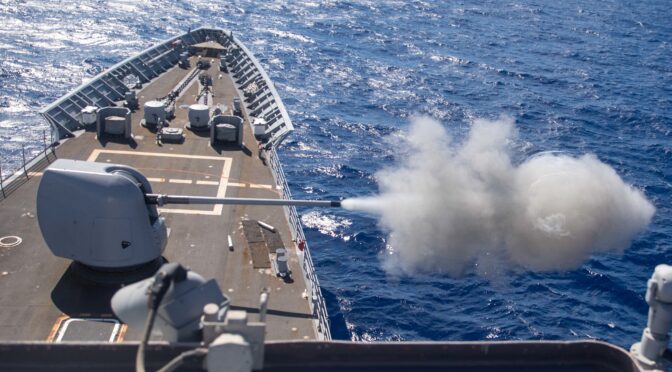By Dmitry Filipoff
This week CIMSEC concludes a special series of notes written by Warfighting Flotilla members to commemorate the second anniversary of the Flotilla. Members discussed practical steps on how to put warfighting first and sharpen deckplate priorities. From organizing war councils to studying doctrine, to improving time management and risk tradeoffs, there are numerous recommendations for how warfighters can double down on core responsibilities.
We thank these authors for their thoughtful contributions.
“Warfighting Culture Starts with the CO,” by Jamie McGrath
“Every aspect of shipboard life is connected to warfighting and therefore should be treated as such. This ethos begins with the commanding officer, but must also be embraced by the wardroom and the chief’s mess.”
“Prepare for the Spectrum of Competition and Warfighting,” by Doug Kettler
“The first duty of a military leader is to ensure their unit is prepared for combat. However, when viewed through the lens of the competition continuum, units must also be prepared to conduct operations short of armed conflict.”
“Command by Example: Learning from San Jacinto’s War Council,” by Capt. Matthew Sharpe (ret.) and GSCM Rich Feldman (ret.)
“With Alexander and his Companions as a model, a select group of officers and enlisted leaders aboard USS San Jacinto (CG 56) met periodically to break bread, bond as warriors, and develop a shared vision of mission success. We called it the War Council.”
“Risk and Time: Calculating Tradeoffs in Warfighting Management,” by Barney Rubel
“Management, defined as the effective use of resources, is a process and skill that permeates the preparation and execution of warfighting. Commanders can prioritize several specific areas to improve their warfighting management.”
“Focus Areas for Putting Warfighting First,” by CDR Paul Nickell
“Marine Corps Doctrinal Publication (MCDP) 1, Warfighting, offers practical steps to emphasize warfighting preparation that each servicemember can implement now. Some of these steps pertain to focus areas that include doctrine, professionalism, training, professional military education, equipping, and personnel management.”
“Streamline Certification and Leverage Lessons Learned,” by Tony Carrillo
“Management makes warfighting possible, but management that enables warfighting needs to be better managed itself. Namely, overlapping lines of reporting and the lack of a strong feedback mechanism to spread the best practices of successful ships are hampering the Navy’s ability to maintain its warfighting dominance.”
“Senior Leaders Must Own the Lack of Warfighting Focus,” by CDR Paul W. Viscovich, USN (ret.)
“If senior Defense Department civilian and military leaders do not seriously convert organizational priorities toward warfighting, any lower-echelon attempt to refocus fighting forces on their core responsibility will achieve only marginal effect. Senior leaders must grasp how deckplate-level reality has become suffocated by miscellanea accumulating from decades of poorly prioritized requirements.”
Dmitry Filipoff is CIMSEC’s Director of Online Content and Community Manager of the Flotilla. Contact him at Content@cimsec.org.
Featured Image: The Ticonderoga-class guided-missile cruiser USS Antietam (CG 54) fires a 5-inch gun during a live-fire gunnery exercise aboard the Ticonderoga-class guided-missile cruiser USS Antietam (CG 54) in Sagami Wan the Philippine Sea, Sept. 21, 2023. (U.S. Navy photo by Mass Communication Specialist 1st Class Ryre Arciaga)

